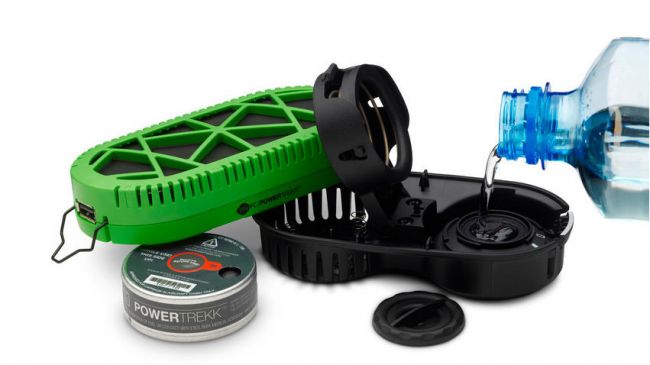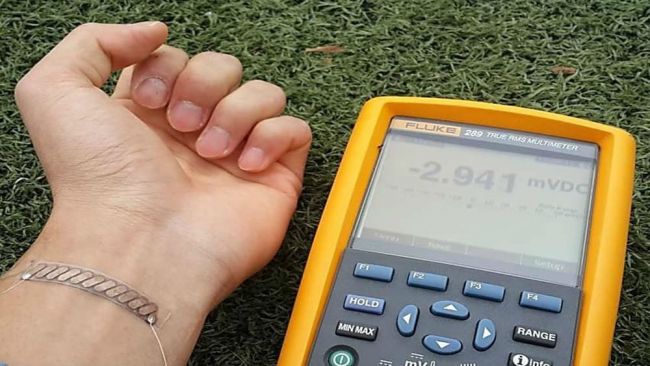



Feature Story
More feature stories by year:
2024
2023
2022
2021
2020
2019
2018
2017
2016
2015
2014
2013
2012
2011
2010
2009
2008
2007
2006
2005
2004
2003
2002
2001
2000
1999
1998
 Return to: 2016 Feature Stories
Return to: 2016 Feature Stories
CLIENT: IDTECHEX
June 6, 2016: TechRadar

It's widely acknowledged that batteries have been holding mobile tech back. Since Volta invented them back in 1800, they've advanced quite a long way from a pile of copper, zinc and brine-soaked rags.
The first public mobile phone, 1973's Motorola DynaTAC prototype, had a battery life of 20 minutes - amazing for the time. That today's power-hungry devices last a day is a testament to two centuries of scientific advancement - but we want more.
To have a truly mobile smartphone experience we need a power source that goes wherever we do - and some engineers think that we are that source, Dr. Natasha Vita-More of the University of Advancing Technology telling us it should be "power that comes from the human body itself."
Imagine if there was a way we could just eat a little more or move more regularly and power those phones ourselves, our bodies literally becoming the power source… and it might not be as far off as you might think.
To find out more, we spoke to three people specialising in this area. They were: Dr Harry Zervos, Principal Analyst at IDTechEx, an expert in thermoelectric energy harvesting; Tom Snyder, from the North Carolina Regional Internet of Things (NC RIoT) centre, who has previously worked in a nanosystems engineering research centre; and the transhumanist Dr Natasha Vita-More, from the University of Advancing Technology.
There are already lots of on the market and plenty more insane concepts for them. These are essentially machines that convert your energetic actions into power, either directly or to be stored in a battery.
Kinetic chargers, machines that convert your movement into power, have been around almost as long as mobile phones. A good current model is the Eton FRX4, which combines a hand-cranked charger, battery and solar panel with a radio and flashlight. It works well generally, but who wants to be cranking a handle to charge an iPhone?
The newest concept is to capture energy passively, as you move. The Ampy is a battery pack containing two sensitive inductors, which capture vibrations from movement.
It contains enough charge for one and a half iPhone batteries, in our estimation, and is about the size of a deck of cards. An hour of exercise produces one hour of active smartphone battery life, or five hours on standby. It's currently available from the Ampy website for around $75.
Yes, wearable solar panels are totally a thing. They make look strange, but it's a rational way to capture power from the source. To make it easier, solar fibers are being developed which can be woven into all sorts of fabrics.

Fashion or power? Or both?
Indeed, these are already commercial. Brands like Tommy Hilfiger have experimented with wearable solar panels integrated into flagship products, like their Solar Powered Jacket, pictured above. Its removable solar panels are water resistant and the lightweight battery contains enough charge for four standard smartphones.
Why is solar so popular? Tom Snyder from NC RIoT explains. "Looking at energy output per unit cost, fossil fuels still rule, but they aren't environmentally feasible or practically applicable for portable electronics and the Internet of Things."
By which he means nobody wants to be carrying around large amounts of explosive fuel.
Snyder emphasises that solar power is now widely, cheaply available, and modern solar tech is efficient - that is, it converts a large amount of light to power.
"Solar has largely commoditized, so costs are nearing grid-scale practicality. Advances in non-silicon based solar will drive power output much higher than 20% efficiency (though at higher cost, so will be applicable for small devices instead of large scale power production)."
By contrast, Dr Harry Zervos is less enthusiastic; "High efficiency solar (e.g. GaAs cells) is one option, but it is very expensive, and does not work well if you're not holding it up to the sky in perfect California sunshine."
And you wouldn't want to be wearing that Tommy Hilfiger jacket in an L.A. summer...
Whereas the kinetic chargers we saw earlier drew current from your physical activity, newer technologies could power our phones just from our breathing or the movement of our clothing.
Piezoelectric materials (known as 'piezos') include a crystalline structure that generates a current when it's bent, pressed or subjected to other stress. Several research studies have experimented with 'piezos', including research that showed that a piezoelectric insole could generate enough power from walking to power 30 LEDs - around 50 milliwatts.
Other studies have implanted piezo fabrics around the lungs and hearts of animals to successfully (if gruesomely) generate power.
"Piezoelectrics hold considerable potential," says Snyder, "but they are still years from practical usage in consumer product applications. Piezos produce very high power outputs, but only for a really short duration, so in aggregate the efficiencies are still very low. These materials are fairly brittle, and often not well suited to larger scale application."
That said, even if 'piezos' aren't currently suitable, Snyder thinks integration of energy harvesting materials directly into textiles has massive potential.
For example, Jess Jur at NC State is working on a low-cost solution to harvest energy from temperature differences across insulation. "[The] near term application [is] on steam pipes and industrial applications, but there's a promising opportunity to build similar devices for apparel. Health monitoring clothing is a holy grail that will be achieved in time."
The kinetic Ampy, above, is covered in a sweat-proof coating, to protect its systems. That would be a terrible idea for some more conceptual chargers, given that they would be using sweat and other bodily fluids as their energy source.
In 2014 Dr Wenzhao Jia, of the University of California, created a prototype charging patch. It uses materials contained in sweat to generate up to 70 microwatts per square cm of skin. Sadly, it was so small that it only produced 4 microwatts of power meaning that 3,000 of them would be needed to power the lowest powered 10 milliwatt LED.
Dr Harry Zervos is skeptical of the state of the technology. "There are many research-level projects, but no commercial momentum to date. Again, the amount of power is too low in most cases, especially from something as power hungry as a mobile phone. However, as skin patches with much lower power consumption begin to see market traction, this becomes a very interesting proposition."
The PowerTrekk, shown below, isn't quite a sweat-powered charger, but it's a similar concept, as it contains a fuel cell that runs on water and salt. It's designed for mobile charging in situations where you have absolutely no access to power lines - and where other methods like solar charging aren't effective, like dark or wintery climates.

Water? Salt? Your body has loads of that.
You simply pour water (or any water-based liquid, like urine) into the container, add a small salt block, and it pumps out enough electricity in two hours to charge a smartphone twice. It's on sale for €99 (around $115) - though the salt pucks cost around €3 / $5 each.
Your blood is ridiculously energetic, with all that glucose floating about, meaning it's just perfect for implanted fuel cells.
However, you can't simply harvest the blood's heat - you have to access the same chemical energy we use ourselves. "There is research in converting chemical energy to electricity to power implantable devices," says Tom Snyder, "which is important since you can't achieve the thermal temperature differential to generate high levels of power inside the body."
EFCs (enzymatic biofuel cells) are devices that extract electricity from a fuel source by using enzymes to catalyze an oxidation reaction. Implanted ones would use the sugar in your blood as the fuel source.
They've been tested internally in rats, rabbits, lobsters and cockroaches, and produced a good 40 microwatts of power. Of course, they have huge problems - they're invasive as hell for one thing - but they'll be ideal for bionic implants because they're cheap to make and practically free to fuel.
And don't worry that they'll steal power from your body, in some hideous Matrix-style dystopia - unless you're diabetic, your body's insulin system automatically adjusts to low blood sugar levels. It might be an exceptionally easy way to lose weight!
Whilst piezoelectrics generate power from deformation, thermoelectrics generate it (you guessed) from heat - specifically, the heat differences between the inside of clothing and the outside. The voltage generated is directly proportional to the heat gradient across them - so extreme weather is ideal for this.
Tom Snyder is highly optimistic about these. "For wearables, the potential for thermoelectrics in particular is much higher and maturity of technology is further along than the other technologies you mention."
An armband form-factor vigilant EKG monitor (an armband which measures your vital signs) that was completely powered by body heat has been demonstrated at the university level by ASSIST, so the systems are feasible.

Nabbing power from your body heat
Similarly, researchers at KAIST (the Korean Advanced Institute of Science and Technology) have created a device that harvests excess body heat to generate electricity. At the moment it only generates around 40 milliwatts. Given that, it's likely to only be used for low-powered devices, like smart watches and smart clothing.
Of course, not all of these devices have to work alone - a combination of techniques could mean higher outputs and allow for redundancy when some sources aren't available. After all, it would be so annoying to not be able to charge your phone from your EFC because you couldn't find a vein...
Dr Harry Zervos has recent experience of this 'multi-mode harvesting'. "I was in Korea earlier this month where one professor told me they had achieved around 5mW harvesting from a combined electrodynamic/piezoelectric/triboelectric unit the size of an AA battery".
"That's still too big, but if they can get that level of harvesting from something AAA-sized or smaller, then one can see the beginning of uptake in the consumer electronics space."
To clarify, that's a device the size of an AA battery that gathers power from magnetic induction, cloth compression and static electricity. That's pretty impressive, but like most of this tech it needs to generate a higher wattage to be useful.
For all mobile devices Dr Harry Zervos thinks wireless charging is an important alternative solution to better batteries and body-derived power sources. "There is still a power problem," he tells us, "so integrating wireless charging, both in devices but also in a broader infrastructure, has been the most prominent commercial method to counter this recently."

Wireless power could soon be everywhere
And wireless charging is already commonplace; heck, even IKEA sell a range of furniture with built-in wireless chargers. It's likely that wireless chargers will be a useful bridging technology for implanted devices, like pacemakers and more futuristic bionic augmentations like implanted phones, which couldn't have large batteries or charging sockets.
Of course, for our purposes, that wireless charger might be drawing on your body's power to charge your phone. Or whatever we have instead of phones by then…
Return to: 2016 Feature Stories